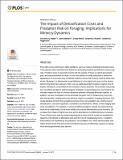Files in this item
The impact of detoxification costs and predation risk on foraging : implications for mimicry dynamics
Item metadata
| dc.contributor.author | Halpin, Christina G. | |
| dc.contributor.author | Skelhorn, John | |
| dc.contributor.author | Rowe, Candy | |
| dc.contributor.author | Ruxton, Graeme D. | |
| dc.contributor.author | Higginson, Andrew D. | |
| dc.date.accessioned | 2017-01-25T12:30:12Z | |
| dc.date.available | 2017-01-25T12:30:12Z | |
| dc.date.issued | 2017-01-03 | |
| dc.identifier | 249000909 | |
| dc.identifier | 156fd55c-9b33-4266-a992-9f306633baa5 | |
| dc.identifier | 85008210818 | |
| dc.identifier | 000391612300097 | |
| dc.identifier.citation | Halpin , C G , Skelhorn , J , Rowe , C , Ruxton , G D & Higginson , A D 2017 , ' The impact of detoxification costs and predation risk on foraging : implications for mimicry dynamics ' , PLoS One , vol. 12 , no. 1 , e0169043 . https://doi.org/10.1371/journal.pone.0169043 | en |
| dc.identifier.issn | 1932-6203 | |
| dc.identifier.other | RIS: urn:3299BBF71EA19C4EFDE93C9863C5EF1E | |
| dc.identifier.other | ORCID: /0000-0001-8943-6609/work/60427470 | |
| dc.identifier.uri | https://hdl.handle.net/10023/10172 | |
| dc.description | This work was supported by the European Research Council (Advanced Grant 250209 to Alasdair Houston), a Natural Environment Research Council Independent Research Fellowship (NE/L011921/1) awarded to A.D.H., a BBSRC-NERC project grant (BB/G00188X/1) awarded to J.S., C.R. and G.D.R. and a faculty fellowship awarded to C.G.H. (Medical Sciences, Newcastle University) with strategic support funding from the Wellcome Trust. | en |
| dc.description.abstract | Prey often evolve defences to deter predators, such as noxious chemicals including toxins. Toxic species often advertise their defence to potential predators by distinctive sensory signals. Predators learn to associate toxicity with the signals of these so-called aposematic prey, and may avoid them in future. In turn, this selects for mildly toxic prey to mimic the appearance of more toxic prey. Empirical evidence shows that mimicry could be either beneficial (‘Mullerian’) or detrimental (‘quasi-Batesian’) to the highly toxic prey, but the factors determining which are unknown. Here, we use state-dependent models to explore how tri-trophic interactions could influence the evolution of prey defences. We consider how predation risk affects predators’ optimal foraging strategies on aposematic prey, and explore the resultant impact this has on mimicry dynamics between unequally defended species. In addition, we also investigate how the potential energetic cost of metabolising a toxin can alter the benefits to eating toxic prey and thus impact on predators’ foraging decisions. Our model predicts that both how predators perceive their own predation risk, and the cost of detoxification, can have significant, sometimes counterintuitive, effects on the foraging decisions of predators. For example, in some conditions predators should: (i) avoid prey they know to be undefended, (ii) eat more mildly toxic prey as detoxification costs increase, (iii) increase their intake of highly toxic prey as the abundance of undefended prey increases. These effects mean that the relationship between a mimic and its model can qualitatively depend on the density of alternative prey and the cost of metabolising toxins. In addition, these effects are mediated by the predators’ own predation risk, which demonstrates that, higher trophic levels than previously considered can have fundamental impacts on interactions among aposematic prey species. | |
| dc.format.extent | 18 | |
| dc.format.extent | 1359305 | |
| dc.language.iso | eng | |
| dc.relation.ispartof | PLoS One | en |
| dc.subject | QH301 Biology | en |
| dc.subject | BF Psychology | en |
| dc.subject | NDAS | en |
| dc.subject.lcc | QH301 | en |
| dc.subject.lcc | BF | en |
| dc.title | The impact of detoxification costs and predation risk on foraging : implications for mimicry dynamics | en |
| dc.type | Journal article | en |
| dc.contributor.institution | University of St Andrews. School of Biology | en |
| dc.contributor.institution | University of St Andrews. Centre for Biological Diversity | en |
| dc.identifier.doi | 10.1371/journal.pone.0169043 | |
| dc.description.status | Peer reviewed | en |
This item appears in the following Collection(s)
Items in the St Andrews Research Repository are protected by copyright, with all rights reserved, unless otherwise indicated.

